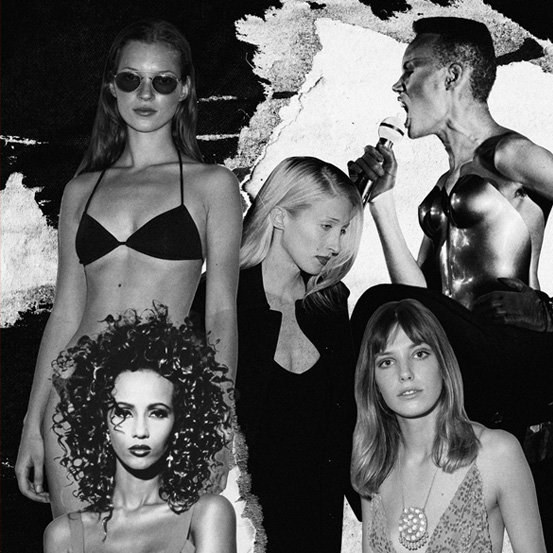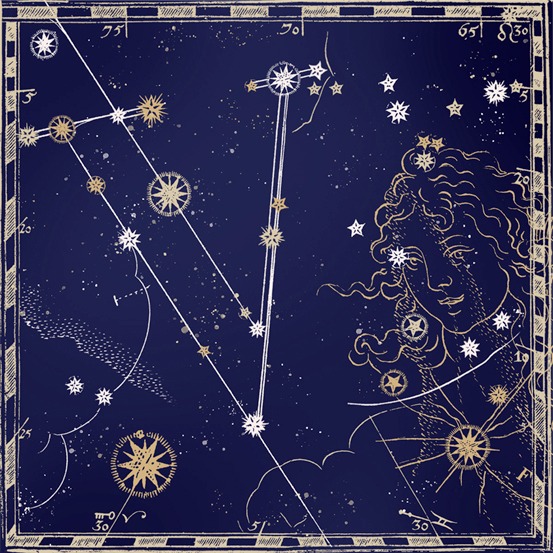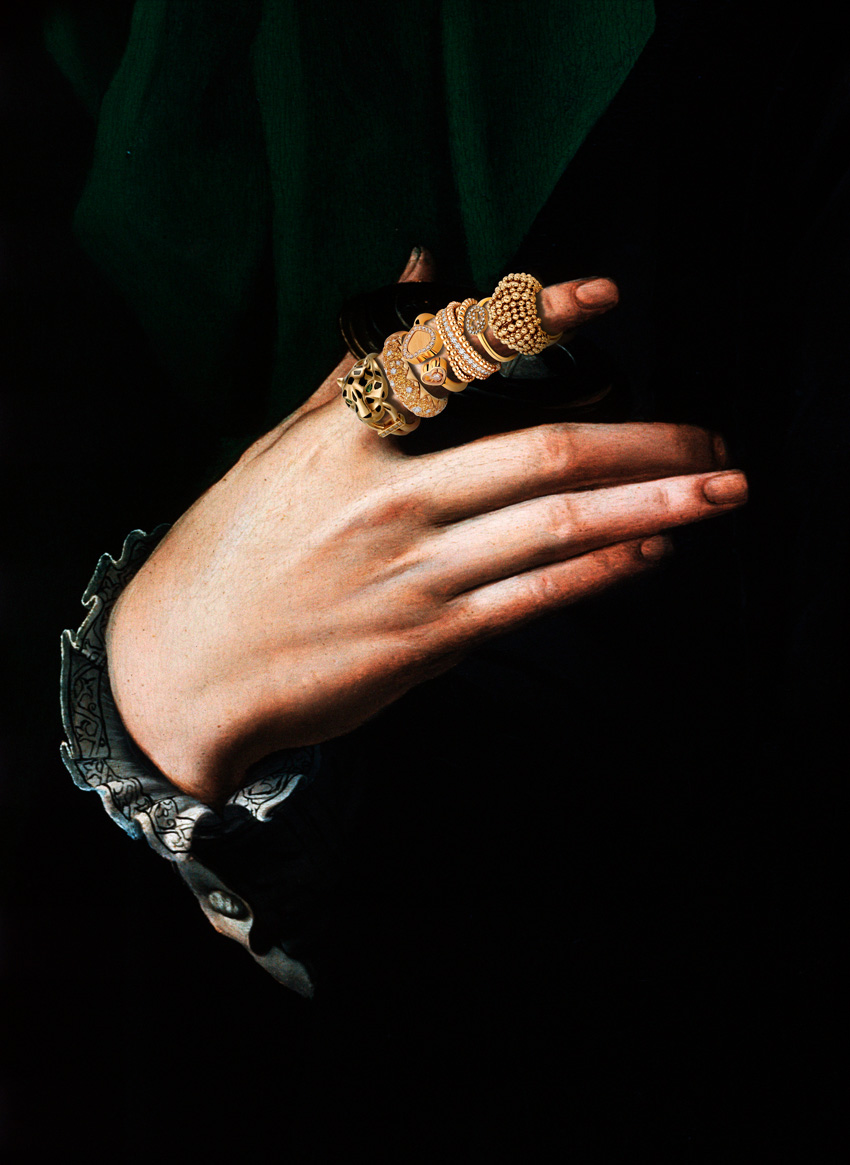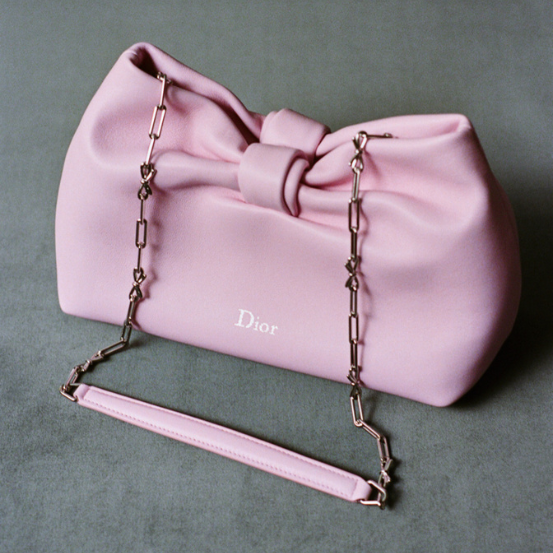Artwork by João Oliveira.
In the duel between jewellery tenets, there are spokespeople who present themselves as representatives of different trends and aesthetic movements. Between the mantras that dictate the supremacy of simplicity and those who allow themselves to be found by the opulence of extravagance, the dilemma remains: if less is more and more is more, how much jewellery should we (really) wear?
In a world ruled by dichotomies, there are deeply fought battles. Along with fashion, in a reality where different trends and aesthetic movements dance with each other in a game of contrasts and textures, jewellery embodies different facets of our intimacy. Authentic batteries for individual reflection, jewellery weaves a juxtaposition between the more and the less and builds a visual narrative that goes beyond clothing. The dualities are countless: think of the mythical duel between metals in gold and silver tones, or the difference between openly delicate pieces and those that are exaggeratedly bulky. In this infinite range of possibilities and proposals, the question is: in the spectrum of minimalism and maximalism that has taken over the main jewellery trends, is simplicity the ultimate key to elegance or is excess a fictional quantifier?
In this eternal war between opposites, there are authorities established at the different poles - and mottos that resonate to this day. Like fashion, jewellery goes beyond mere adornment; it’s a practice of identity expression that allows us to communicate experiences and emotions that have shaped us. Filled with symbolism and meanings derived from a multitude of precious stones, jewellery reveals pieces of our history and sometimes even acts as an amulet or carrier of subliminal messages. It’s under this motto of timelessness that the minimalist aesthetic emerges as one of the forces in the jewellery prism. Spearheaded by Coco Chanel's emblematic saying ‘less is more’, this style allows simplicity to speak louder and relies on the rules of functionality hidden by elegance. Complementing the quiet luxury trend that, season after season, insists on being present on the most diverse catwalks and collections, in jewellery, minimalism consists of choosing versatile pieces, but with a more geometric, polished and unornamented design that values the essence of quality. In one of the most interesting interpretations of this aesthetic, Carolyn Bessette-Kennedy took minimalism to its avant-garde extreme during the 90s. The daughter-in-law of John F. Kennedy achieved it-girl status with a purposely simple style, whose rotation of outfits included little (if any) jewellery. Decades later, the trend was replicated on the red carpets during the 2023 award season, and the absence of jewellery in the looks of the main stars of the artistic worlds of cinema and music during that time proved what we had long taken for granted: jewellery, be it full of sparkles or just a metallic accent, adds a touch of impeccable refinement to any silhouette. In everyday life, among sober proposals that become absolute classics - such as Cartier's Love bracelet or Tiffany & Co. diamonds - minimalist jewellery weaves a story that spans lives and generations, combining the mastery of delicate know-how with the sophistication of timelessness.
On the other side of the pendulum, the maximalist aesthetic knows no limits and believes that virtue lies as much in quality as in quantity. Between dramatic and sometimes theatrical looks, this style is governed by the laws of boldness and opulence. Like a kind of armour, maximalist jewellery is defined by more than bold details, irreverent ornaments or eclectic palettes: it is something emotional, which allows us to create imagined realities and give free rein to fashion's unique creativity. In this extraordinary universe, the rules are to be taken as suggestions, and the motto is that more is always better. In complete opposition to the minimalist movement, maximalism argues that clothing and the way we adorn our bodies should be seen as an explosion of identity and fun. In jewellery, it's names like Bulgari, particularly with their Serpenti collection, or Gucci with its chunky and colourful proposals, that give credit to this bold trend - as Iris Apfel's famous saying reminds us, ‘When the fun goes out of dressing, you might as well be dead’. A fusion of shades, metals and precious stones in the most diverse cuts, this aesthetic has peculiarities that take visuals and mentalities to new extremes and is often associated with some of the fashion world's most iconic personalities. In an interview with Highsnobiety, Donatella Versace admitted that exaggeration and boldness are inescapable values in her daily life: ‘Minimalists have minimal ideas. I think they go together. [...] So I’m maximalist’. What's more, as the designer reveals, even when she tries to adopt a minimalist approach when creating collections, Versace's maximalist DNA prevails, resulting in creations with typically exaggerated proportions, rather than an ode to simplicity. However, there are also crossovers between the different jewellery philosophies, and even Chanel (renowned for its minimalist sophistication) has gone down the maxi route. Under the direction of Karl Lagerfeld, the Maison's Spring 1992 Haute Couture collection proposed classic silhouettes with details that catapulted the pieces in the show to the status of true works of art - such as a black dress adorned with a gold jewellery piece with floral details and precious stones in shades of red. The dress, originally worn by Christy Turlington on the catwalk, once again shone on the legendary steps of the Metropolitan Museum in New York during the 2019 Met Gala, this time on Lily-Rose Depp, proving that, more often than not, the answer to this never-ending duel lies in the perfect harmony between the two aesthetics.
The truth is that, throughout history, there have been those who have taken on the role of being messengers of different philosophies when it comes to wearing jewellery. Inspired by a Venn diagram, the war that draws the boundaries between minimalism and maximalism leads to a range of possibilities that unite the true essence of both movements. Beyond the social meanings that pursue and characterise each limit of this duality, jewellery is defined as a visual narrative that doesn't adhere to formulas or delineated rules but is governed solely by the personal taste that defines identities and shapes experiences. From monochrome jewellery to pieces that cover every shade of the rainbow, both aesthetics appear as the antithesis of each other, celebrating different aspects of the creativity so present in contemporary fashion. Wearing jewellery ends up being an extension of our individuality, and the pieces we choose evoke our most genuine selves. Whether it's a tribute to exuberance or simplicity, jewellery has the power to transform mere clothing combinations into absolutely extraordinary looks. In this game of extremes, it’s not who ends the duel with more or fewer pieces on the board that wins: the winner depends solely on the context and personal style of each individual. With no mathematical end in sight, even after all the philosophies and movements have been considered, the rules of jewellery remain paradoxical, in the hope that one day, perhaps, a new aesthetic will emerge that questions the current norms and proves to be definitive when it comes to organising our jewellery box.
Translated from the original on "What's Next" issue, published December 2024. Full credits and stories in the print issue.
Most popular



Relacionados






 (1).png)
